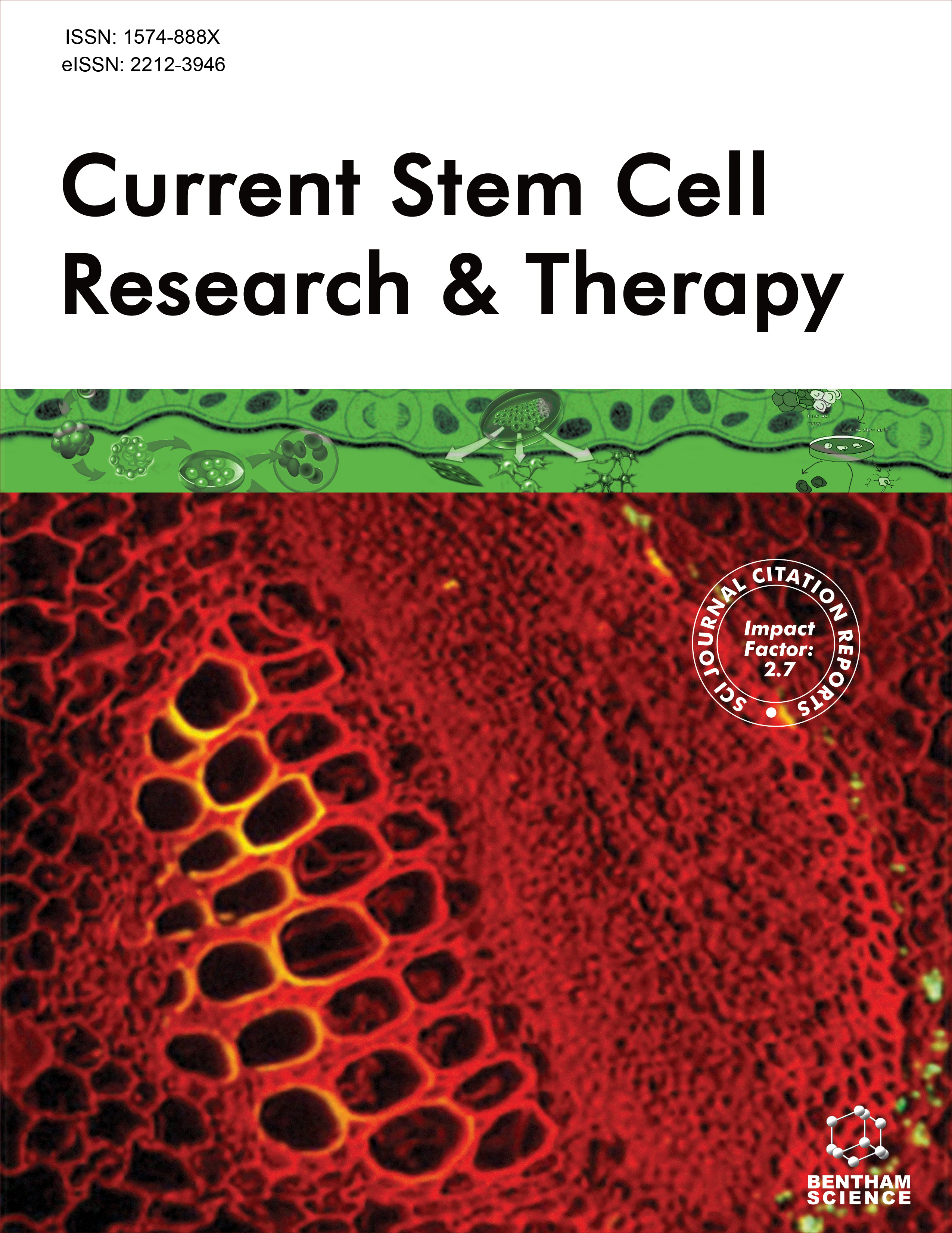- Home
- A-Z Publications
- Current Stem Cell Research & Therapy
- Previous Issues
- Volume 8, Issue 5, 2013
Current Stem Cell Research & Therapy - Volume 8, Issue 5, 2013
Volume 8, Issue 5, 2013
-
-
γ-Secretase-Regulated Signaling Typified by Notch Signaling in the Immune System
More LessAuthors: Hisashi Nagase and Kohzo NakayamaNotch signaling mediates the fates of numerous cells not only in the nervous system but also in the immune system. Notch signaling contributes to the generation and maintenance of hematopoietic stem cells, lymphocyte development, and several immune responses. The molecular mechanism of Notch signaling is unique: ligands bind to the extracellular domain of Notch and trigger sequential proteolytic cleavages. F Read More
-
-
-
Chondrogenic Potential of Two hASCs Subpopulations Loaded onto Gellan Gum Hydrogel Evaluated in a Nude Mice Model
More LessCells constitute one of the fundamental components of any cartilage tissue engineering approach. Adipose tissue derived stem cells (ASCs) have a promising future considering the abundance of this tissue in the human body, ease of harness, and the high number of stem cells that can be isolated from small amounts of tissue. However the stromal vascular fraction of the adipose tissue that is isolated upon digestion by coll Read More
-
-
-
In Vitro Hematopoiesis Reveals a Novel denDritic-Like Cell Present in Murine Spleen
More LessAuthors: Pravin Periasamy and Helen C. O’NeillDendritic cells (DC) are important antigen presenting cells (APC) which induce and control the adaptive immune response. In spleen alone, multiple DC subsets can be distinguished by cell surface marker phenotype. Most of these have been shown to develop from progenitors in bone marrow and to seed lymphoid and tissue sites during development. This study advances in vitro methodology for hematopoiesis of dendritic-like Read More
-
-
-
Utility of Cryopreserved Umbilical Cord Tissue for Regenerative Medicine
More LessAuthors: Mahmood S. Choudhery, Michael Badowski, Angela Muise and David T. HarrisMSCs can be isolated from adult sources such as bone marrow and adipose tissue. In contrast to these adult tissue sources, harvesting MSCs from cord tissue is a non-invasive procedure and poses no risk to the donor. Stem cell banks offer the opportunity to cryopreserve cord tissue as a source of MSCs for future autologous or allogeneic stem cell based regenerative medicine applications. There is little published data ho Read More
-
-
-
Current and Future Applications for Stem Cell Therapies in Spine Surgery
More LessSpinal surgery involves the bone-cartilage-neural interface. It is a field of surgery that is rapidly changing and evolving; not only through the development of novel techniques, approaches and devices but also through evidence from large clinical trials assessing indications, efficacy and outcomes. The use of biologics in spine surgery has now become widespread. Biologics in the form of autologous or allogeneic stem cell Read More
-
-
-
Umbilical Cord Tissue Mesenchymal Stem Cells: Characterization and Clinical Applications
More LessUmbilical cord tissue (CT) can provide a virtually unlimited source of multipotent mesenchymal stem cells (MSC) that can potentially be used in a variety of regenerative medicine and tissue engineering applications. Cord tissue segments can be frozen and preserved in liquid nitrogen dewars for prolonged periods of time, having been frozen in time at the peak of biological activity. CT stem cells are capable of giving rise to var Read More
-
-
-
Adipose-Derived Stem Cells and Platelet-Rich Plasma: The Keys to Functional Periodontal Tissue Engineering
More LessAuthors: Morikuni Tobita and Hiroshi MizunoNumerous different types of periodontal tissue regeneration therapies have been developed clinically with variable outcomes and serious limitations. A key goal of periodontal therapy is to regenerate the destroyed periodontal tissues including alveolar bone, cementum and periodontal ligament. The critical factors in attaining successful periodontal tissue regeneration are the correct recruitment of cells to the site and t Read More
-
-
-
Induced Pluripotent Stem Cells for the Treatment of Stroke: The Potential and the Pitfalls
More LessAuthors: Fenggang Yu, Yingying Li and Cindi M. MorsheadThe extraordinary discovery of induced pluripotent stem cells (iPSCs) has led to the very real possibility that patient-specific cell therapy can be realized. The potential to develop cell replacement therapies outside the ethical and legal limitations, has initiated a new era of hope for regenerative strategies to treat human neurological disease including stroke. In this article, we will review and compare the current app Read More
-
Volumes & issues
-
Volume 20 (2025)
-
Volume 19 (2024)
-
Volume 18 (2023)
-
Volume 17 (2022)
-
Volume 16 (2021)
-
Volume 15 (2020)
-
Volume 14 (2019)
-
Volume 13 (2018)
-
Volume 12 (2017)
-
Volume 11 (2016)
-
Volume 10 (2015)
-
Volume 9 (2014)
-
Volume 8 (2013)
-
Volume 7 (2012)
-
Volume 6 (2011)
-
Volume 5 (2010)
-
Volume 4 (2009)
-
Volume 3 (2008)
-
Volume 2 (2007)
-
Volume 1 (2006)
Most Read This Month
Article
content/journals/cscr
Journal
10
5
false
en


